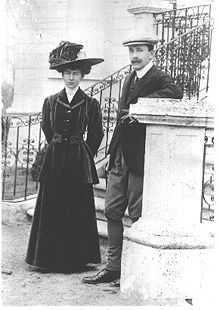László Széchenyi
| László Széchenyi | |
|---|---|
 | |
| Born |
Count László Széchenyi de Sárvár-felsővidék February 18, 1879 Horpács, Hungary |
| Died |
July 5, 1938 (aged 59) Budapest, Hungary |
| Nationality | Hungarian |
| Occupation | Austro Hungarian military officer, Imperial Chamberlain, diplomat, venture capitalist |
| Years active | 1879–1938 |
| Known for | Husband of Gladys Vanderbilt |
| Notable work |
Hungary’s first Minister to the United States Hungary’s first Minister to the Court of Saint James in England |
| Spouse(s) | Gladys Vanderbilt Széchenyi (1908–1938) his death |
| Children |
Cornelia Széchenyi (1908–1958) Alice Széchenyi (1911–1974) Gladys Széchenyi (1913–1978) Sylvia Széchenyi (1918–1998) Ferdinandine Széchenyi (born 1923) |
| Parent(s) |
Count Imre Széchenyi de Sárvár-felsővidék Countess Maria Alexandra Josepha Joanna Sztáray-Szirmay de Sztára, Nagymihály, Csernek, Tarkeö, Szirma et Szirmabessenyő |
Count László Széchenyi de Sárvár-felsővidék (SZÉCHENYI László Jenő Mária Henrik Simon) (Horpács, 18 February 1879–Budapest, 5 July 1938) was an Austro Hungarian military officer, Imperial Chamberlain, diplomat and venture capitalist.
Life
He was a son of Count Imre Széchenyi de Sárvár-felsővidék, who was one time Austrian Minister at the Court of Berlin,[1] and countess Alexandra Sztaray-Szirmay et Nagy-Mihály.
Count László was twenty-eight years old, when he met Gladys Vanderbilt. He was the youngest of four brothers. The eldest, Count Dionys, who was Minister Plenipotentiary and Councilor of the Austrian Embassy at Paris. His wife was Comtesse Marie de Caraman et Chimay. The other brothers, Peter and István, were unmarried. All of the brothers were Reserve Lieutenants in the Imperial Hussars as well as Chamberlains at the Court.[2]
He married Gladys Vanderbilt Széchenyi on January 27, 1908 at her family home in New York City, after their meeting in Berlin near her twenty-first birthday in 1907. Their early married life was spent in Hungary raising their five children.[3]
Count László Széchenyi was the inventor of the submarine wireless telegraphy, for sending and receiving sound-wave vibrations underwater, and started the Submarine Wireless Company to produce it.[1]
Children of Count László Széchenyi and Gladys Moore Vanderbilt:
- Cornelia Széchenyi (1908–1958) (married Eugene B. Roberts (1898–1983) of Bowie, Maryland, and had three children, Gladys, Cornelia and Eugene)
- Alice Széchenyi (1911–1974) (married Hungarian Count Béla Hadik (1905–1971) and had two sons, László and János)
- Gladys Széchenyi (1913–1978) (married the English Earl of Winchelsea and Nottingham (1935–1946)), and had two sons, Stormont (born 1936) and Robin (born 1939)) divorced; in 1954 married Arthur Talbot Peterson (1905–1962)
- Sylvia Széchenyi (1918–1998) (married Hungarian Count Antal Szapáry (1905–1972), and had two children, Pál and Gladys)
- Ferdinandine Széchenyi (born 1923) (married the Austrian Count Alexander zu Eltz (1911–1977) and had two sons, Peter and Nicholas)[4]
By 1908, Count László Széchenyi de Sárvár-felsővidék was the most prominent member of his family, which was quite numerous. He possessed two great estates in Hungary, Oermezo Castle, which is about three hundred years old and 4,000 acres, in the County of Templen, and Lagoshara Pusbla, a Summer place, about 4,300 acres, in the County of Somogy. The Count, besides, also owned a one-story, ten room house at 14 Eotvoss-street in Budapest.[5][6] [7]
Shortly before the War, Count László Széchenyi de Sárvár-felsővidék tried to become a financial Napoléon in Hungary and met his Waterloo very quickly. He is said to have lost $4,000,000 which is supposed to have come largely from his wife. He was a member of the ‘Magnates Group’ which speculated in mines, railroads and other enterprises. They failed to calculate the impact of the World War, and suffered a complete smash as a result of the fall in value of their shares.[5]
Count László Széchenyi presented his credentials as Hungary’s first Minister to the United States on January 11, 1922. He served until March 31, 1933. He was transferred to the same post at the Court of Saint James in England in 1933.[8]
Count László Szécheny died in Hungary in 1938.[8]
References
- ↑ 1.0 1.1 "SZECHENYI COMPANY USES HIS INVENTION - The Count's Submarine Wireless Tried Out by Torpedo Boat at Newport. - View Article - NYTimes.com". query.nytimes.com. Retrieved 2014-10-24.
- ↑ "The Esoteric Curiosa: Cash For Coronets: A 'Ruritanian' Coupling The Likes of Anthony Hope, Vanderbilt & Széchenyi.". theesotericcuriosa.blogspot.com. Retrieved 2014-10-24.
- ↑ Newport Art Museum (R.I.) (2000). Newportraits. University Press of New England. p. 177. ISBN 9781584650188. Retrieved 2014-10-24.
- ↑ "Gladys Moore Vanderbilt - The Free Online Dictionary and Encyclopedia (TFODE)". de.enc.tfode.com. Retrieved 2014-10-24.
- ↑ 5.0 5.1 "The Esoteric Curiosa". theesotericcuriosa.blogspot.com. Retrieved 2014-10-24.
- ↑ "Count Szechenyi's Summer Seat - Oermezo, is a Picturesque Village of About 1,000 Inhabitants in Upper Hungary. Miss Gladys Vanderbilt's Future Neighbors. - View Article - NYTimes.com". query.nytimes.com. Retrieved 2014-10-24.
- ↑ "The Washington bee. volume (Washington, D.C.) 1884-1922, January 04, 1908, Image 3 « Chronicling America « Library of Congress". chroniclingamerica.loc.gov. Retrieved 2014-10-24.
- ↑ 8.0 8.1 "Hungary - Countries - Office of the Historian". history.state.gov. Retrieved 2014-10-24.
- New York Times: Gladys Vanderbilt to marry Count Laszlo Szechenyi
- New York Times: Marriage of Gladys Vanderbilt to Count Laszlo Szechenyi